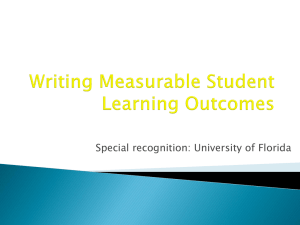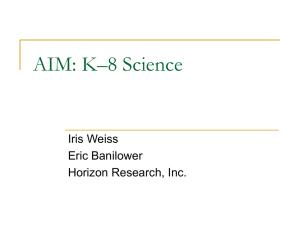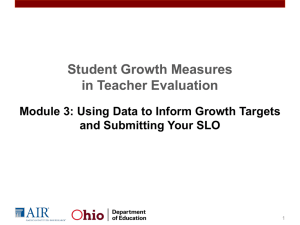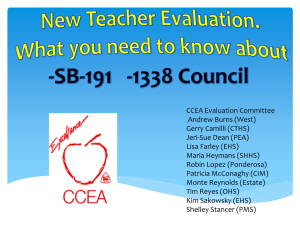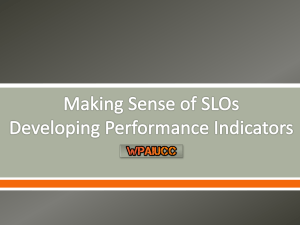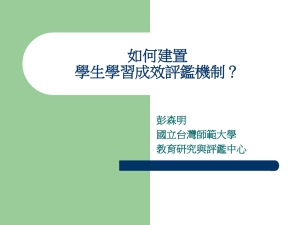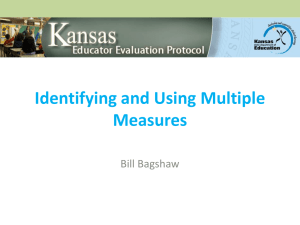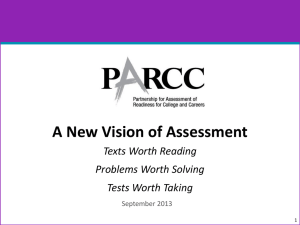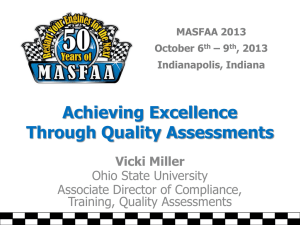2A Selecting or Creating Assessments C3 Day 2 TJ
advertisement
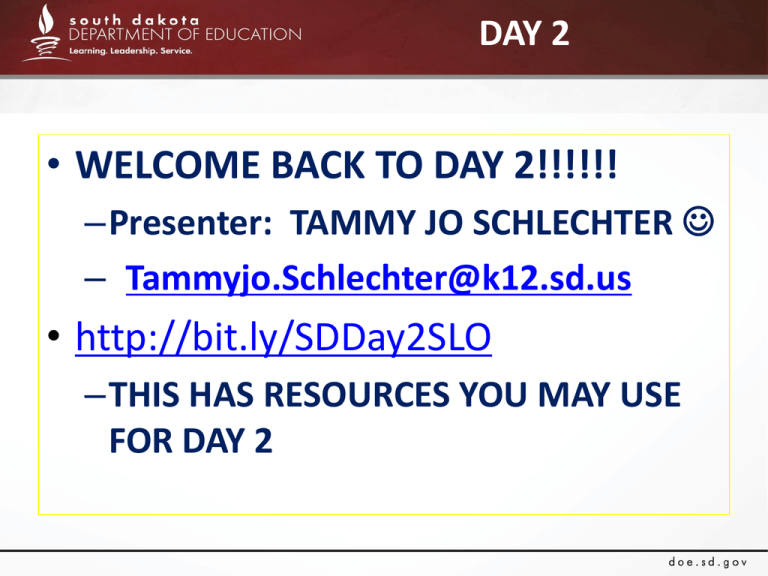
DAY 2 • WELCOME BACK TO DAY 2!!!!!! –Presenter: TAMMY JO SCHLECHTER – Tammyjo.Schlechter@k12.sd.us • http://bit.ly/SDDay2SLO –THIS HAS RESOURCES YOU MAY USE FOR DAY 2 SLOs and Assessments Selecting or Creating Assessments to Establish and Assess SLOs Good morning! Welcome! https://www.youtube.com/watch?v=_W1cN66 V4Qg 2 S.M.A.R.T. Growth Goal A.K.A. OUR “S.L.0.” By the end of the day, 85% of the participants in the training will have a specific plan for their S.L.O. including their assessment piece. WARMUP ACTIVITY AB PYRAMID GAME: Find a partner from a different table… let’s make peanut butter and jelly like yesterday. (One partner faces the board, the other faces the back wall) Round 1 • • • • Student Growth Baseline Data High Growth S.M.A.R.T. Goal Round 2 • • • • Student Learning Objective Expected Growth Growth Goal Student Population Round 3 • • • • Webb Levels Baseline Assessment Priority Content Content Standards Round 4 • • • • Summative Assessment Reliability Alignment Stretch What did we learn yesterday? • S.L.O. Definition and 4 step Process • How to Calculate Growth Ratings and Link Between Teacher Evaluations & S.L.O.’s • Different ways to write Growth Goals • Format of the Process Guide Determining Teacher Effectiveness Using multiple measures of professional practice and student learning South Dakota Framework for Teaching Student Growth Domain 1 Domain 2 Domain 3 Domain 4 SLOs Planning and Preparation Classroom Environment Instruction Professional Responsibilities State Assessments • Classroom Observations and Evidence of Effective Practice • Components from Each of the 4 Domains (as one measure if available) District Assessments Evaluator-Approved Assessments • At Least 8 Components Chosen Based on District or School Priorities Professional Practice Rating Growth Rating Summative Rating Matrix Professional Oversight: Is the rating fair and accurate based on the evidence and data shared by the teacher Differentiated Performance Categories Below Expectations Meets Expectations Exceeds Expectations SLOs & Danielson components • • • • • 1c-Setting Instructional Outcomes 1f-Designing Student Assessments 3d-Using Assessment in Instruction 4a-Reflecting on Teaching 4b-Maintaining Accurate Records Agenda– GET SOME WORK DONE!!!!!!!!!!!!!! 1. Priority Content - Focused or Comprehensive? Course or Class? Standards covered? 2. Assessment - Assessment Methods & Options? - Assessment Quality Guidelines? 3. Sharing & Work Time What Will Be the Scope of SLOs? From yesterday Comprehensive Scope Essential Skills and Content Focused Scope (e.g., all Grade 8 Common Core State Standards for English language arts [ELA]) (e.g., all Grade 8 Common Core State Standards for informational text in ELA) (e.g., Grade 8 Common Core State Standards for evaluating arguments and claims in text) Strengths Drawbacks Strengths Strengths Drawbacks • Covers all • Can be • Focuses on learning difficult or most • May work cumbersome important well for to assess well learning courses that already have finals or cert. exams Drawbacks • Can still be • Can difficult to focus on assess well area of • Involves need judgment to • Easiest determine of the what is three to most assess important • Not representative of the learning that occurred during the course Norms for the Day Listen with Engagement Honor Each Other’s Thinking Honor Private Think Time Everyone has a Voice Be Respectful of all Comments Limit Side Conversation Take Care of Your Needs Cell Phones Off/Vibrate Video-- Look for something you connect with… http://bit.ly/SDDay2SLO Task during the video: Jot down 2 or 3 statements/ideas you connect with in the video. “Hello, PARTNER!” • Find a partner with a similar characteristic for today. • Discuss the 2 or 3 statements you jotted down and connected with from the video… S.L.O. Process Guides • Do you have yours out from yesterday?? • Do you want a fresh one? – Paper copy – Computer copy What do I want my students to know and be able to do? – Identify the core concepts and standards. • What resources might you use to determine big/essential ideas? – i.e. blueprints, disaggregated standards, curriculum maps, power standards, national standards, content standards and common core standards – Know your timeline for instruction Prioritizing Learning Content Prioritize Learning Content: Identify standards and content. What is the most important learning that needs to occur during the instructional period? Specify which standard(s) the SLO addresses and Identify the specific data source or trend data used. (1a) Students can write, apply, and use expressions, equations, and inequalities (7th and 8th). (EE) Students can apply previous understanding about arithmetic to algebraic expressions; reason about and solve one-variable equations and inequalities; and represent and analyze quantative relationships between dependent and independent variables (6.EE). Students can use properties of operations to generate equivalent expressions and solve real-life and mathematical problems using numerical and algebraic expressions and equations (7.EE). Students can work with radicals and integer exponents; understand the connections between proportional relationships, lines, and linear equations; and analyze and solve linear equations and simultaneous linear equations (8.EE). Pre-test Last years end of year data Statewide summative data Other… Trend data District assessment data Prioritizing Learning Content Prioritize Learning Content: Identify standards and content. What is the most important learning that needs to occur during the instructional period? Specify which standard(s) the SLO addresses and Identify the specific data source or trend data used. (1a) REFINE OR REDO IDENTIFY STANDARDS & CONTENT 30 minutes of Work Time!!! Sharing a Resource and a Moment Teenagers and texting. Where’s the math? http://mathsnacks.com/scaleella.php Resource • http://doe.sd.gov/ContentStandards /index.aspx –Other content areas –Unpacked standards Resource • http://sdccteachers.k12.sd.us –Blueprints –Disaggregated common core standards Resource parking lot • Please share your assessment resources, books, websites, tools, etc. on the resource parking lot. • Let’s do this: every time we take a break, each person share a resource etc. that you are using at the Parking Lot BREAK TIME 10 MINUTE BREAK When Tammy Jo ends video abruptly, that signals when we will begin. https://www.youtube.com/watch?v=w_hph89OA8I Let’s think about assessments! Why the focus on assessments? • Assessments are the backbone of the SLO process. – “An SLO is only as good as the assessments upon which it is built.” • Bad data in, bad data out. • Assessment comparability between teachers in like subjects is valuable for many reasons. 32 WEBB LEVELS General types of assessments • State assessments-can be used to identify priority content and standards • Commercially available assessments • District or team-created assessments • Teacher-created assessments General types of assessments • State assessments-can be used to identify priority content and standards • Commercially available assessments • District or teamcreated assessments • Teacher-created assessments • These assessments can be both FORMATIVE and SUMMATIVE, depending on how they are administered and how the results are used. SD Assessment & SLO Facts How do state assessments impact SLOs? SBAC DSTEP Science • Individuals who • Individuals who teach ELA or math at teach sciences grades 3-8, and 11 grades 5,8, or 11 must write an SLO must write an SLO based on ELA or based on science. math. Grade 5 teachers who teach ELA, math, and science must select one of those content areas on which to write the SLO. How do state assessments impact SLOs? Future SBAC/ former DSTEP • Individuals who teach ELA or math at grades 3-8, and 11 are to use state level assessment data in the decision making process when selecting priority content and standards for the SLO. DSTEP Science • Individuals who teach sciences grades 5,8, or 11 are to use state level assessment data in the decision making process when selecting priority content and standards for the SLO. Think-Pair-Share Take time to discuss… • What options are available in your district??? • What are you going to use for your S.L.O. ASSESSMENT??? –A. COMMERCIAL ASSESSMENT –B. DISTRICT CREATED ASSESSMENT –C. TEACHER CREATED ASSESSEMENT How do state assessments impact SLOs? So, what does that mean for me as an ELA, math, or science teacher? • It means that your SLO, like all instructional decisions, should be based on available data, whether it be assessment data, grades, failure rates, student work samples, etc. Priority Content & Assessment Revisiting Webb Levels • • • • • • Knowledge Reasoning Skill Product Disposition Find handouts 1 and 2 for next task Evidence of learning: reasoning Peanut Butter and Jelly Partner Share : • Silent reading- “Peanut Butter” reviews handout 1, and “Jelly” reviews handout 2. • Sharing- “Peanut Butter” has one minute to share about handout 1, then “Jelly” has one minute to share about handout 2. Evidence of learning: reasoning • • • • • • Inductive and deductive reasoning Analytical reasoning Comparative reasoning Classification Evaluative reasoning Synthesizing • Find handouts 3 and 4 Evidence of learning: reasoning Peanut Butter and Jelly Partner Share : • Silent reading- “Peanut Butter” reviews handout 3, and “Jelly” reviews handout 4. • Sharing- “Peanut Butter” has one minute to share about handout 3, then “Jelly” has one minute to share about handout 4. Assessment Methods & Options Assessment methods: Selected response/short answer • • • • • Multiple choice True/false Matching Fill in the blank Labeling Assessment methods: extended written response • Students construct a written response to a question or task that is at least several sentences in length. • For example, *Compare pieces of informational text, solutions to problems, world events. *Analyze forms of government, artwork, methods for completing tasks. *Interpret scientific information, music, polling data. *Describe in detail a process or principle. Different methodsdifferent responses • Let’s compare a selected-response item with an extendedresponse item. Multiple choice A teacher is planning a field trip and will need school buses to transport students. A school bus holds 36 students. If 1,128 students will be transported, how many buses are needed? a.31 c. 32 b.31.33 d. 36 Extended written response A teacher is planning a field trip and will need school buses to transport students. A school bus holds 36 students. If 1,128 students will be transported, how many buses are needed? Explain your answer. Show your work. Are these answers correct? • If you have 31 buses, there are 12 people left over. These 12 people can squeeze into 31 buses. So, they just need 31 buses. • You need 31 buses, but there are 12 people left. They need to go too. But one bus for these 12 people is too big, so you just need another minivan. Therefore the answer is 31 buses and 1 minivan. • Twelve people are left, another bus is needed for 12 people, so the answer is 32. Assessment methods: performance assessment • Students demonstrate a skill or develop a product. The assessment is based on observation and a scoring rubric. –Thinking through a story problem –Find a new way to visualize a concept –Performance Tasks –Use a Rubric?? One math performance task Scoring performance assessments • • • • • • Define and describe quality with common language Define distinguishable levels of success Focus on important content Align with standards Provide models Use no ‘fudge words’ such as adequate or sometimes • Use positive language in all descriptors, such as ‘do use black ink,’ instead of ‘do not use red ink’ • Use non-value based adjectives Handout 5 Assessment method: personal communication • Students provide information about what they have learned through interaction with teachers and other students. –Questions and answers –Class discussions –Conferences/Interviews –Oral examinations –Journals and logs Spend some time exploring • http://www.smarterbalanced.org/sm arter-balanced-assessments/#item RESOURCES Elbow Partners: Revisit Handout 4 and then discuss the Webb Levels found in the assessments you currently use. Do you feel you could adapt questions if they are predominantly at a Webb Level 1 or 2? Poll Everywhere Activity: Poll Everywhere • https://www.polleverywhere.com/f ree_text_polls/3Mb7iiGc1dUMqsC Possible lunch break moment here! http://blog.mrmeyer.com/category/3 acts/ Teacher’s Anthem for Round Up After Lunch • https://www.youtube.com/watch?v=RelL-PdcCSk • Which assessment methods might work best for your priority content/standards? – – – – selected response extended written response performance assessment personal communication Assessment quality guidelines • Now that you have priority content/standards in mind and are considering an assessment method, let’s discuss assessment quality. Assessment Quality Guidelines Assessment quality guidelines • • • • Alignment Stretch Validity Reliability 77 Alignment considerations • Assessments should cover key subject and grade-level content standards. • No items, questions, or prompts should cover standards that the course does not address. • The assessment structure should mirror the distribution of teaching time devoted to course content. • The cognitive demand of the assessment should match the full range of cognitive thinking required during the course. 78 Stretch • Assessments should: – Allow both low- and high-performing students to demonstrate growth. – Challenge highest performing students. Student A Student B Student C Lowest performing students Student E Student D Student F Highest performing students 80 Validity and reliability considerations • The assessment should: – Be valid—it measures what it says it measures. – Be reliable—it produces consistent results. – Contain clearly written and concise questions and directions. – Be fair to all groups of students. 82 ASSESSMENT QUESTIONS • Is my assessment ALIGNED to the correct content/standards? • Does my assessment STRETCH enough to allow me to measure growth for low achieving and high achieving students? • Is my assessment Valid, Reliable, and Fair? PEOPLE SEARCH: Review Plus New 1) 2) 3) 4) Discuss the 4 steps of the S.L.O. process. What are the most important aspects for us to focus on this summer? Explain how a teacher’s summative teacher effective rating is determined. (Below, Meets, or Exceeds Expectations) Discuss the Assessment aspect of the S.L.O. process. What assessments are needed and why? Explain what it means for your assessment to be aligned, have stretch, have validity and have reliability. Intel resources • http://www.intel.com/content/ww w/us/en/education/k12/assessingprojects/strategies.html TAKING A LOOK AT HANDOUT #10 and the MATH SAMPLE DO WE HAVE ACCESS TO IT?? Need a paper copy?? TAKE A LOOK AT THE ASSESSMENT USING THE S.L.O. Assessment Checklist… Validity & reliability scenario • A team of band teachers create a performance assessment for students. In addition to developing the tasks together, the teachers specify a set of directions and testing conditions that each teacher will follow. For example, each student will be asked to perform a short piece of music during small-group lessons. • All teachers will assess the students using the same band rubric. Prior to grading, teachers will practice using the rubric and make sure they are grading performances consistently. Any validity concerns with this assessment? 87 Assessment considerations • With a partner, review the scenarios on Handouts 6-9 and use the bulleted questions to guide your discussion. • Table share in 15 minutes. 88 Tool for Assessment Selection and Development Use the quality checklist Handout 10 to review the assessment you brought with you today or use the assessment provided by the trainer. • What new information did the checklist help you notice about the assessment? • What revisions might need to be made to the assessment? • How might using the checklist impact your selection of assessments in the future? 89 Assessment Creation guidelines • Develop assessments collaboratively. • Align all assessments to standards. • Align assessments with district, school, or other identified goals. • Make sure all your priority content is covered in the assessment. • Incorporate items that vary in difficulty. • Include a sufficient number of test items to ensure rigor. • Collaboratively determine possible modifications if needed. • Make sure content-and skill-based rubrics are specific and address multiple levels of proficiency. WEBB LEVELS • Go to SDAP power point to share this resource, if needed. • https://sdap.emetric.net/Portal • Your Take Out • Take a break and we will have our work session. The work session will provide you with something for “take out”... For your classroom! TIME TO WORK • PREPARING YOUR PRETEST… • YOUR GOAL FOR THIS WORK TIME IS TO PREPARE YOUR PRE-TEST and POSSIBLY EVEN BEGIN TO ADJUST IT TO MAKE YOUR PROGRESS UPDATE AND POSTTEST… Poll Everywhere • https://www.polleverywhere.com/ multiple_choice_polls/2DQx5gbjvj4 2jGs • https://www.polleverywhere.com/f ree_text_polls/qYzLK4a2tFcrX8u • https://www.polleverywhere.com/f ree_text_polls/Bzxnmq4lcYnzmlt Reflection • Why is selecting appropriate assessments important? • What are the benefits of using common assessments? • What resources or supports exist in the school district or at the school to help teachers select appropriate assessments? • What additional supports are needed? 97 On a sticky note • Share your “take away” about today and what your ideas are for your assessment piece of your S.L.O. S.M.A.R.T. Growth Goal A.K.A. OUR “S.L.0.” By the end of the day, 85% of the participants in the training will have a specific plan for their S.L.O. including their assessment piece. Are we moving up the mountain? Where are you now in your comfort level with writing and/or determining an assessment for your SLO? Going from the valley of confusion up the slope of understanding? (Top 20 lingo here. Giggle) • Tammyjo.Schlechter@k12.sd.us • 605-381-6252 EVALUATION • https://www.surveymonkey.com/s/ slo day1 (if you did not get there yesterday) • https://www.surveymonkey.com/s/ slo day2 Sparkling in Education with You! I would love to hear your feedback about today’s presentation! If you have a couple moments, please share with Tammy Jo about the things we should A. Definitely Keep. B. Possibly Change. Thank you! Tammy Jo needs to take attendance before her guests leave! Tammyjo.Schlechter@k12.sd.us

